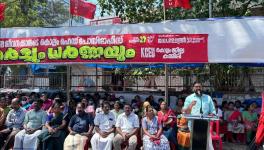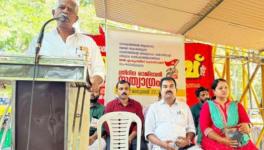How Women Beedi Workers Set Up Asia’s Largest Housing Cooperative
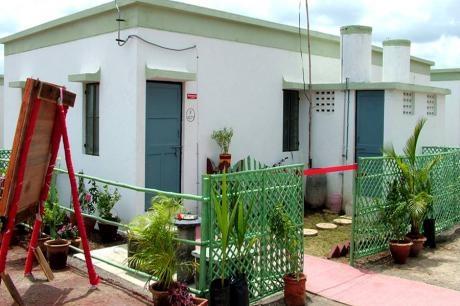
Image Courtesy: The Centre of Indian Trade Unions.
"Earlier we used stay in a small hut in a slum in Shastri Nagar, Solapur city. When it rained, the hut used to leak, and there wouldn't be a single dry patch inside. We had to continuously bail out the water when it rained," says Balamani Ambaiah Mergu. She is rolling beedis, a thin cigarette, at her house at Kumbhari, the site of a housing initiative led by the Centre of Indian Trade Unions’ (CITU).
Mergu, whose mother tongue is Telugu, is one of the beedi workers who are part of the first of the housing projects in Solapur, in south-eastern Maharashtra, a state in west India. The project, named after the late communist leader Godavari Parulekar, counts 10,000 houses and was hailed as the biggest of its kind in Asia.
The housing initiative by the CITU in Solapur is a landmark effort which has provided affordable housing to thousands of workers.
By forming cooperatives and by persuading the federal and state governments to dedicate funds for the purpose, the workers have had more than 15,000 houses built since 2001. The construction of another 30,000 houses began in January 2018, and is expected to be completed in four years.
From the slums of Solapur to housing projects
According to the last Census of India in 2011, Solapur has a population of around 950,000, 18 per cent of whom live in slums. However, the number of slum dwellers is significantly lower now than in 2001, when the figure hovered around 25 per cent. Workers’ struggles which led to the building of mass housing were the prime catalysts for this change.
The women beedi workers of Solapur, many of them sole bread-winners for their families, are low-paid and were living in tiny shanties on rent in slums. The closing of the textile mills in Solapur, starting in the 1980s, and the handloom industry working below capacity, led to high unemployment. The beedi workers, most of whom are from lower castes and religious minorities, saw their wages being adversely affected.
There are about 65,000 beedi workers in Solapur, and their dismal living conditions prompted the CITU – a trade union with more than 5.8 million members across India as of 2015 – to take up the issue of providing them decent and affordable housing.
The CITU office in Solapur city is located in a working class area next to a slum of the kind described by Mergu. Most of the CITU activists in Solapur are either workers themselves, or full-time activists from working class backgrounds.
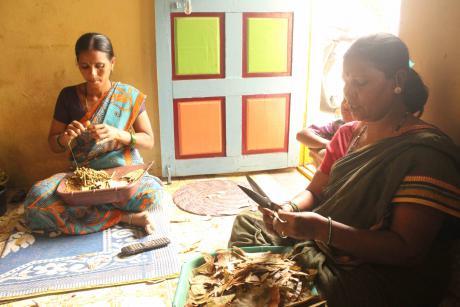
Balamani Ambaiah Mergu, a beedi worker (on the right), at her house in Kumbhari. Credit: Subin Dennis.
The struggle which led to the housing initiative began in 1992, with the workers in Solapur under the leadership of CITU demanding affordable housing. Narsayya Adam, CITU leader and three-time Member of the Maharashtra Legislative Assembly from the Solapur city (North) constituency played a pre-eminent role in initiating and leading the campaign. He is popularly known as ‘Adam Master’, or Teacher Adam, as he taught mathematics to children, despite not being able to continue formal studies beyond Standard X, the equivalent to 11th year in England.
One earlier housing scheme proved unaffordable for the workers, who struggled to pay the monthly instalments. Their debt accumulated, and the failure of the project resulted in the CITU intensifying its movement for workers’ housing. “Between 1992 and 1995, CITU constantly raised the demand for housing for beedi workers,” says Aparajita Bakshi, professor at the Tata Institute of Social Sciences, Mumbai, who wrote a research note in 2012 on the CITU’s housing initiative in Solapur.
“In 1995, Adam Master won the legislative assembly elections. In the same year he raised the issue of housing for beedi workers at the legislative assembly in a memorable speech that he delivered on the conditions of beedi workers in Solapur,” she writes in her note.
As a result of these efforts, the state government agreed to reach a one-time agreement with the owners of the houses under the earlier scheme, to settle the accumulated debt. Meanwhile, Adam proposed a new housing scheme for beedi workers, under which the estimated cost of constructing the house, including purchasing the land, would be Rs. 60,000 (approximately 640 British pounds). The cost was to be shared equally by the worker, the central government and the state government.
Cooperative housing societies lead the way
The workers had to wage a long, drawn out struggle to win their demand. They formed cooperative housing societies to drive the initiative. Through mass mobilisations, protest actions and campaigns, they forced central and state governments to allot funds for the construction of houses.
Naseema Shaikh, who joined the movement as a teenager, gave us a glimpse into the mobilisation strategies adopted to organise workers in demonstrations and rallies. “Comrade Adam Master used to roam around in a bicycle, and he organised meetings of workers in slums. We formed teams of four to five women workers,” she explains during an interview at the Solapur city office of the Women Beedi Workers' Cooperative Housing Society.
“By the late 1990s when the agitation for cooperative housing reached its peak, we used to gherao [prevent (someone) from leaving a place of work until certain demands are met] every minister who visited Solapur, demanding to know the status of our housing project,” she says in a mix of Hindi, Urdu and Marathi.
Adam, now a Central Committee member of the Communist Party of India (Marxist), the CPI(M), remembered an example of the opposition and prejudice they had to encounter when the workers initially approached the government with their proposal for the housing project: “When we approached Satya Narayan Jatiya, the Labour Minister at the centre, he claimed that this was a scheme for us to embezzle money.”
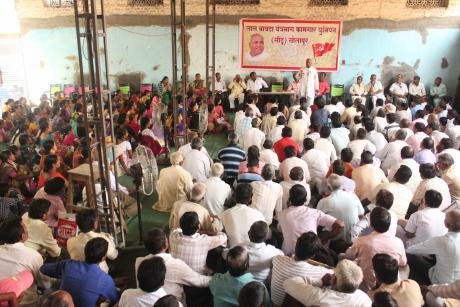
Narsayya Adam addressing a meeting of workers at the CITU office, Solapur city. Credit: CITU.
According to CITU activists, mainstream political groups including the Indian National Congress (which has been the ruling party in India for the longest period since independence) were sceptical of the initiative. But the union’s campaign resulted in the initiative winning support from political leaders in Maharashtra across the political spectrum.
“Sharad Pawar, Sushil Kumar Shinde, Manohar Joshi, Chandrakant Khaire, Mulayam Singh Yadav and seven to eight MPs of the CPI(M) together gheraoed Prime Minister Atal Bihari Vajpayee on 8 March 2000, Women's Day. ‘What is the issue,’ he asked, and they explained the demand to him. ‘Come to my office’, said the PM. After reaching the office, he called Jatiya and directed him to sanction the 10,000 houses’ project,” Adam fondly recalls the key victory when major leaders hailing from various political parties joined hands to put pressure on the central government.
An historic inauguration
After several rounds of negotiations, the proposal was sanctioned on March 8, 2001. Construction was carried out by Pandhe Constructions, a local firm, and the completed Godavari Parulekar Housing Scheme was inaugurated on 1 September 2006 by the then-Prime Minister Manmohan Singh. The public meeting was attended by more than 100,000 people.
A typical house unit in the scheme is around 555 sq. ft (around 50 square metres), and the project is spread across 182 hectares, at Kumbhari, about 8 km from Solapur city. The project includes open spaces as well as the land required for community services, schools, hospitals etc. The state and federal governments contributed to the construction of electricity lines, an electric sub-station and water tanks. The Municipal Corporation of Solapur has provided the water supply.
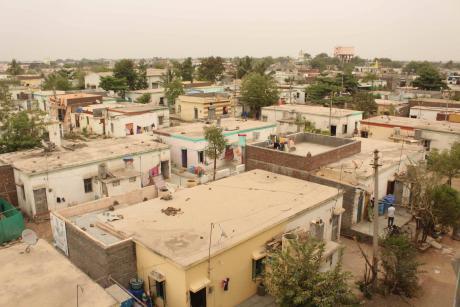
Godavari Parulekar Housing Scheme. Credit: Subin Dennis.
Each worker was able to buy a house for Rs. 20,000 (around 210 British pounds), a third of the total cost. Workers paid their share in instalments, and the funds for this purpose were drawn from their personal savings and their social security funds.The central government’s share for the scheme came from the Beedi Workers Welfare Fund, which consists of the tax collected on manufactured beedis.
The second scheme, inaugurated in 2015 and dubbed the Comrade Meenakshitai Sane Housing Scheme, involved building 5,100 houses for women beedi workers.The third scheme is the biggest, and aims to construct 30,000 affordable houses for beedi workers, textile workers and other unorganised sector workers at a total cost of Rs 18.11 billion (around 193 million British pounds). Workers have been organised into five cooperative societies – that of minority women workers, workers belonging to the traditional cobbler community, power loom workers, women beedi workers, and readymade & tailored clothes workers.
These five cooperatives have come together to form the RAY Nagar Cooperative Housing Federation. Massive demonstrations and rallies were held to mobilise support and to persuade the federal and state governments to provide funds for this scheme as well. The governments gave the green light for the project in 2016, and the scheme is expected to be completed by 2021.
From a village to a vibrant small town
The shift from city slums to the houses at Kumbhari constituted a major advance for the workers. But the people who moved into the houses at Kumbhari faced difficulties in transportation for the first two years. Then the CITU persuaded the Solapur Municipal Transport – the transport utility of the Solapur Municipal Corporation – to start bus services to Kumbhari. The bus fare from anywhere in Kumbhari to Solapur city has been kept low, at Rs. 7 (seven British pence).
“We have also brought the beedi industry here. Twenty work sheds have been constructed and provided to the beedi industry at minimal rent,” M.H. Shaikh, Maharashtra State General Secretary of the CITU, explained. Beedis are made in households by women workers, and the rolled beedis are collected at the work sheds.“The men in the households work in the power loom sector, and many power loom industries have migrated here automatically. So the men also don't have to go far for work.”
“We persuaded the Zila Parishad [the local administrative body at the district level] to start schools for the children here. We gave land for the purpose for free, and there are six big primary schools here now. There are also five high schools in the area,” Shaikh said in an interview at the CPI(M) office in Kumbhari.
A cooperative hospital nearby has been persuaded to provide free emergency treatment to the people of Kumbhari, and to charge low rates for other kinds of treatment. Efforts to get the central government to set up a 100-bed hospital where treatment is provided for free are on-going.
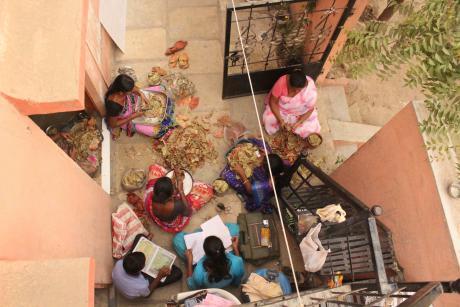
Women rolling beedis at Kumbhari09 - Women rolling beedis at Kumbhari. Credit: Subin Dennis.
Kumbhari, which was previously a village, is now a buzzing small town with the arrival of nearly 50,000 people as part of the housing schemes of the CITU and smaller schemes set up by others. Commercial amenities have been provided, and shops that sell various commodities have cropped up. The vegetable market at Kumbhari’s Kranti Chowk (“Revolution Square”) bustles with customers from 5 in the evening until 10 at night.
The united struggle by the workers of Solapur, organised into cooperatives, has resulted in a remarkable shift away from their earlier, insecure lives in rented homes. The slums that still exist in Solapur today are cramped shacks separated by lanes that are sometimes only a metre wide. Drains with coloured water – due to effluents from textile units – flow through the slum near the CITU office in the city. “We have managed to bring people out of such hazardous living conditions,” Shaikh said.
The housing initiatives of the CITU in Solapur have become landmarks in the history of low cost mass housing, working class movements, cooperative movements and the role of the government in the creation of social security with people’s participation. This mass housing project has proven that workers can achieve their dream of housing on the sheer strength of their own sustained movements, and with the cooperation of governments.
Get the latest reports & analysis with people's perspective on Protests, movements & deep analytical videos, discussions of the current affairs in your Telegram app. Subscribe to NewsClick's Telegram channel & get Real-Time updates on stories, as they get published on our website.










